Swami had blessed these couples the day prior in the evening of the 16th itself when He went around and personally distributed clothes to the brides and grooms to wear on the wedding day the following morning.
On the morning of the 17th, the couples and their relatives marched in a procession from the Old Mandir to Sai Kulwant Hall around 7:30 A.M. They were seated in front of the veranda and all the ingredients for performing the marriage ritual ceremony were placed in front of them. Three priests seated next to Swami on the veranda lead the chants and invocations and guided the couples through the ceremony.
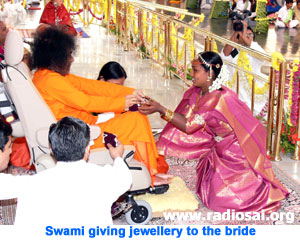 Swami went around the hall and personally distributed the mangal sutra (or the wedding band) that the groom ties around the bride.
Swami went around the hall and personally distributed the mangal sutra (or the wedding band) that the groom ties around the bride.
It was quite touching to see Swami play the role of the Divine Parent and bless His children who are starting life in holy matrimony. But the blessings did not end there.
Seemingly there is no end to His giving. After the mangal sutras had been distributed, He had all the brides come up to Him one-by-one and handed over the marriage jewellery to them from His Own Divine Hands. What glorious good fortune.
And all the brides took full advantage by also taking the padanamaskar of His Divine Lotus Feet. What an auspicious start to their married life!
 But the copious giving still did not end. After the end of the Vedic wedding ceremony, when the bride and the groom had now become a wedded couple, the elders normally bless them by sprinkling akshada (rice mixed with turmeric powder) on their heads. These blessed and lucky couples had the rarest of rare fortunes to be blessed by the Lord Himself, for Sai decided that He was going to go around for the third time amongst these chosen couples and bless them Himself. There was scarce a dry eye as the Lord went around again, ignoring all physical discomforts and lovingly blessed each and every one of the couples who had got married on that morning by sprinkling akshada on their heads!
But the copious giving still did not end. After the end of the Vedic wedding ceremony, when the bride and the groom had now become a wedded couple, the elders normally bless them by sprinkling akshada (rice mixed with turmeric powder) on their heads. These blessed and lucky couples had the rarest of rare fortunes to be blessed by the Lord Himself, for Sai decided that He was going to go around for the third time amongst these chosen couples and bless them Himself. There was scarce a dry eye as the Lord went around again, ignoring all physical discomforts and lovingly blessed each and every one of the couples who had got married on that morning by sprinkling akshada on their heads!
And after the wedding was over, still the giving did not stop! Swami even provided a wedding feast for the 80 couples and about 600 of their close relatives in the canteen. Truly there is no better way to begin married life than with these undreamt blessings from the Lord Himself on His 80th year of Advent!
NOV 18 MORNING: THE ANNUAL RATHOTHSAVAM CEREMONY
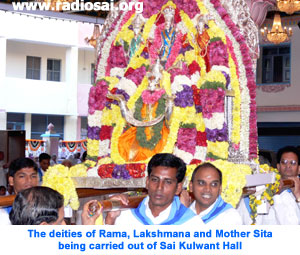 The Rathothsavam festival is always held on the morning of the 18th of November, when the deities of Rama, Lakshmana and Sita along with their bhaktha Hanuman is taken out along the streets of the village right up to the Old Kalyana Mantapam.
The Rathothsavam festival is always held on the morning of the 18th of November, when the deities of Rama, Lakshmana and Sita along with their bhaktha Hanuman is taken out along the streets of the village right up to the Old Kalyana Mantapam.
On another chariot is Lord Krishna in all His Glory. These two chariots are carried by Seva Dals on their shoulders and the citizens of Puttaparthi greet these chariots and offer arathi as the procession slowly wends its way through the village.
The procession is led by Swami's pet elephant Sai Gita followed by the nadaswaram troupe. Swami's students chant the Vedas dressed in the traditional attire of a red dhoti and a white angavestram (upper cloth).
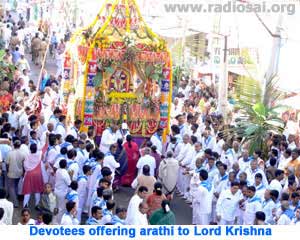 This is followed by the students singing bhajans and then come the 2 chariots. The Rama, Sita and Lakshmana deities go first, with Lord Krishna in a big chariot bringing up the rear. The streets of the village have been freshly washed by the citizens and intricate floral patterns (called rangolis) have been drawn on the clean roads through which the chariots are going to pass.
This is followed by the students singing bhajans and then come the 2 chariots. The Rama, Sita and Lakshmana deities go first, with Lord Krishna in a big chariot bringing up the rear. The streets of the village have been freshly washed by the citizens and intricate floral patterns (called rangolis) have been drawn on the clean roads through which the chariots are going to pass.
A palpable air of devotion pervades the atmosphere as the devotees throng the streets in their hundreds and drink in their fill of the Lords. The chariot wends its way very slowly satisfying one and all, till it reaches the Old Kalyana Mantap. There an arathi is performed by the ashram priest to Lord Krishna and He is left there for the night. The procession then wends its way back to the mandir with the smaller deities of Rama, Lakshmana and Mother Sita.
Thus these deities are taken out annually with full devotional fervour to give the devotees a chance to feast on their beauty and further their own devotion.

NOV 18th EVENING: A CHINESE ORCHESTRA PERFORMANCE IN SKH
 During the Tang Dynasty in China , the Chinese scholar and monk - Xuan Zang, traveled to India to bring back the sacred teachings of the Buddha to China .
During the Tang Dynasty in China , the Chinese scholar and monk - Xuan Zang, traveled to India to bring back the sacred teachings of the Buddha to China .
More than two millennia later, on the 18 th of November, a group of devotees from Singapore , together with seven instrumentalists from the People’s Republic of China , were blessed with permission by our Dearest Lord to present a cultural programme in Sai Kulwant Hall as part of the 80 th Birthday Celebrations.
Seeing this as an opportunity for the Lord’s children to demonstrate their filial piety towards their Divine Parent, the group started the performance in the traditional Chinese manner with offerings of longevity - Peaches and Noodles which were presented to Swami, Who lovingly accepted them.
This was followed by the musical presentation. These accomplished musicians from mainland China played a mixture of bhajans and traditional Chinese melodies. The instruments used each had at least two thousand years of history behind them.
They were:
Erhu : a two-stringed bowed instrument.
Pipa : a four-stringed pear-shaped lute.
Yangqin : dulcimer of varying lengths of strings struck with a pair of two padded bamboo mallets.
Guzheng : one of the oldest plucked instruments with 16-26 strings.
Dizi : traditional Chinese flute.
Sheng : a mouth organ consisting of varying numbers of bamboo pipes. |
|
 |
The mounting anticipation could be felt throughout the hall during the length of the introduction as most of the audience had never heard or witnessed Chinese instrumental music, much less a live instrumental bhajan performance by a Chinese Orchestra.
As the first notes shattered the pregnant silence these musicians from China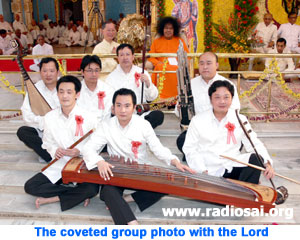 captured the entire audience and held them hostage to each tug of the bow and each strum of the strings from these unusual instruments.
captured the entire audience and held them hostage to each tug of the bow and each strum of the strings from these unusual instruments.
Having such music in Prashanti was definitely a very welcome addition to the various kinds of music from around the globe that we hear here. The programme was warmly received by everyone and all of us hope that they will be back soon to enchant us again with their lilting music.
Swami Himself was extremely happy on that day, smiling broadly. And as for the devotee musicians - to have the Lord, our God, savouring their performance with everyone was more than enough to fill their hearts with bliss and their eyes with tears.
Bhagavan blessed the performers at the end by posing for a few photos with them. Bhagavan specifically asked the instrumentalists to pose along with their instruments and they felt extremely blessed to be photographed with Baba on their very first visit.
NOV 19th: LADIES DAY CELEBRATION IN PRASHANTI NILAYAM
The Morning Program
Ten years ago, on Nov 19, 1995, on the occasion of the 70th Birthday celebrations, Bhagavan magnanimously declared that the 19th of November will henceforth be celebrated as Ladies' Day to highlight the sacred qualities of women and lay renewed emphasis of the quality of motherhood. Ever since, it has been the privilege of women to celebrate this day as Ladies’ Day in His Divine Presence at Prashanti Nilayam.
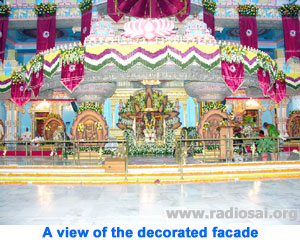 Yet another red letter day for Ladies dawned this year on Nov 19th. On this day all the Mandir activities starting from the morning Suprabhatham to the Nagarsankeertan are carried out exclusively by ladies.
Yet another red letter day for Ladies dawned this year on Nov 19th. On this day all the Mandir activities starting from the morning Suprabhatham to the Nagarsankeertan are carried out exclusively by ladies.
As the devotees streamed into Sai Kulwant Hall, they were welcomed by elegant decorations that brought out the innate but most oft unnoticed beauty of the Hall. Floral decorations hung in an arc around the dais of the verandah. Intricately lit-up wooded carvings of the dasavataras (the 10 incarnations of Vishnu) were tastefully arranged around the verandah, lending a serene air to the atmosphere.
Large oversized banners, each with a portrait of Bhagavan and an inspirational quote, hung from strategic positions on the rafters. The dais had a beautiful picture of Easwaramma just behind the lion statue with an oil lamp that was waiting to be lit by Bhagavan. 
A large picture of Mother Easwaramma was also hung from the back of the Hall so that she could benignly watch over the entire day's proceedings.
Bhagavan was escorted into Sai Kulwant Hall by the Nadaswaram Band from the Anantapur Campus and by the girl-students of the Sri Sathya Sai Primary & Higher School dressed in Indian traditional attire chanting the Vedas. Swami inaugurated the Ladies Day function by formally lighting the lamp and then signaled for the festivities to start.
The Primary School Girls dressed in "Scottish style" skirts gave a spirited display of bagpipe music that thrilled the crowd, some of whom were hearing bagpipe music for the first time.
Bhagavan then released a Souvenir commemorating the 80th Year of Love in action, brought out by Easwaramma Women’s Welfare Trust, Prashanti Nilayam before the speeches for the day.
 The first speaker was Smt. Mallika Srinivasan, an MBA from the Wharton School of Business, University of Pennsylvania, USA and Director of Tractors and Farm Equipment Limited (TAFE). She said, "Bhagavan’s Omnipresence makes each one of our experiences unique and personal. As we each personally experience His grace we see Him in a variety of hues as a parent as a teacher, as a personal guide as a protector from danger as a corporate guru, as a friend and as God.
The first speaker was Smt. Mallika Srinivasan, an MBA from the Wharton School of Business, University of Pennsylvania, USA and Director of Tractors and Farm Equipment Limited (TAFE). She said, "Bhagavan’s Omnipresence makes each one of our experiences unique and personal. As we each personally experience His grace we see Him in a variety of hues as a parent as a teacher, as a personal guide as a protector from danger as a corporate guru, as a friend and as God.
Swami we know You as our inner confidence. We realize You as our inner strength we feel You as the quiet witness of our being. When we determine to follow our hearts You are by our side. When we learn to care and share, You show us how and where. When we are compelled to face difficulties You give us compassion and courage. When we decide to become self reliant You place us on the path of Dharma.
On Ladies Day last year Bhagavan inaugurated the Easwaramma Women’s Welfare Project. And on the 19 th July this year He launched the mother and Child Programme. Give a man bread and you feed him for a day. Teach him how to farm and you feed him for life. The Easwaramma Women’s Welfare Project is powered by this idea of self reliance and sustainable development.
Through this programme women are trained in a variety of skills using locally available material to make products such as papads, snacks, wicks and tailored clothes. The products distributed through Bhagavan’s institutions act as a both a service to devotees and a source of income to those women whose livelihoods have hitherto depended on meagre seasonal earnings from subsistence farming.
The Mother and Child Programme has been initiated by Swami for the health and well being of mothers and their expectant children. It is only by the strength of a mother’s will that a child can come up in life; hence she must be cared for. "
 Smt. Geeta Ram, a school teacher from Washington D.C., speaking next, related enthralling incidents from her life showing Swami's omnipresence and omnipotence. The first incident related to her family and her infant son who was raised on Glaxo baby food.
Smt. Geeta Ram, a school teacher from Washington D.C., speaking next, related enthralling incidents from her life showing Swami's omnipresence and omnipotence. The first incident related to her family and her infant son who was raised on Glaxo baby food.
When a strike in the factory threatened the supply, she sent her husband to buy some scarce packets. On the way he saw a car that had broken down and helped the driver to push it to the side. The driver requested him to deliver a parcel for him. After he had come home, he realized that the parcel was addressed to his wife and contained 25 packets of the much needed Glaxo baby food. Their ardent prayers to Bhagavan had been answered in a dramatic fashion.
In another incident, Swami had given Mrs. Gita Ram a packet of Vibhuti in the interview room which she placed in her purse and forgot about it over time. A few months later, when she and her husband were attending a Music Concert in a New York theatre, she went to the Ladies Room during the intermission. A Hispanic Woman asked Mrs. Gita on finding out that she was an Indian, if she knew Sai Baba and then also asked her if she had some "white powder" with her.
Apparently Swami, in answer to her prayers to Lord Jesus to save her 8 year old daughter who had failure in both kidneys, had visited her in her dream and asked her to collect the white powder from an Indian lady and give it to her daughter. With a prayer Mrs Geeta Ram opened her purse and located the long forgotten Vibhuthi packet which she handed over to the Hispanic lady. Months later, Swami in an interview, told her, "The girl is fine. Both her kidneys are OK. No surgery!"
 The third speaker for the morning was Smt. Chetana Raju, who spoke about Bhagavan's mission and exhorted everyone to derive the maximum benefit of having the Lord in our midst. She said, "What is 80 years for the One who is ageless? What is 80 years of earthly existence for the One who is beyond time? What is 80 years for the One who is proclaimed by the Vedas as Sathya Brahman? And what is 80 years for Sri Sathya Sai who is existence eternal?
The third speaker for the morning was Smt. Chetana Raju, who spoke about Bhagavan's mission and exhorted everyone to derive the maximum benefit of having the Lord in our midst. She said, "What is 80 years for the One who is ageless? What is 80 years of earthly existence for the One who is beyond time? What is 80 years for the One who is proclaimed by the Vedas as Sathya Brahman? And what is 80 years for Sri Sathya Sai who is existence eternal?
We have been watching a profound transformation in the collective consciousness of the planet and beyond. It is a quantum leap in the evolution of consciousness and our only chance of survival as a race.
Six decades ago in 1940 when Bhagavan was Sathya then, at the age of 14, He declared 'I AM SAI BABA meaning ‘I Am Universal Mother and Universal Father.’ At that time Mother Easwaramma hardly knew that her little son was going to be recognized as Bhagavan Sri Sathya Sai Baba of the Universe in the years to come. Bhagavan said ‘My devotees are calling Me’ and He left the house. His parents and family had to sacrifice their little lad for the sake of humanity.
In 1947 when Bhagavan was 21, He declared His mission statements and said ‘I have a task to foster all mankind and ensure lives full of ananda. I have a vow; to lead all those who stray away from goodness back to goodness and save them. I am attached to the work that I love; to remove the sufferings of the poor and grant them what they lack’."
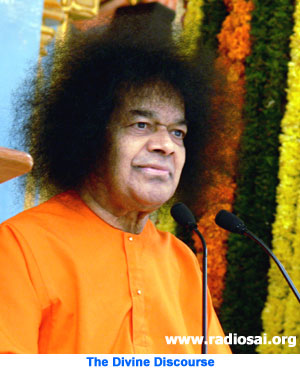 |
|
At the end of Smt. Chetana's speech, Bhagavan, to the delight of all, consented to give His Divine Discourse. He said,
"In this cosmic drama, God alone is the director and also the actor. He is donning all the roles such as mother, father, husband, wife, daughter, son, etc. Someone says, 'I have been blessed with a grandson today.' The grandson is a manifestation of Brahma. Brahma alone assumes various names and forms in this world.
It is God who speaks through each one of you. You should have this firm conviction. If someone accuses you, think that God in that form is accusing you. When you develop such a spirit of oneness and tolerance, you will never be perturbed by censure and blame. Your mind will always remain in peace. Whatever may happen, accept it wholeheartedly as the Will of God. Have firm faith that it is God, and God alone who is the doer. Do not consider your fellow human beings as mere individuals. When you talk to someone, think that you are talking to God. When you do not see God in others and treat them as your own, you will be giving room to evil qualities like anger, jealousy, hatred, etc. Develop the spirit of oneness. Only then will your life be redeemed ".
|
Bhagavan next related in very loving tones the three promises that He had given to Mother Easwaramma (to provide drinking water for the village, to provide elementary healthcare in the village and a school for the children so that they would not need to walk to the nearest village) that had finally resulted in the Sri Sathya Sai Water Project, The Hospital Projects and a University in rural Andhra Pradesh. Bhagavan concluded His Divine Discourse with the bhajan, “Prema Muditha Manase Kaho …”

The Evening Programme
Bhagavan was again led into the Sai Kulwant Hall in the afternoon by the bands of the Anantapur Campus, of the University and of the Primary School. As He arrived on the specially decorated dais of the Hall, Smt. Kavita Subramaniam (formerly Kavita Krishnamurthy), renowned playback singer, and her husband the world renowned violinist Dr. L. Subramaniam were waiting to offer a bouquet of songs at His Lotus Feet, as a part of the Ladies’ Day celebration.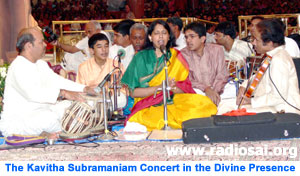
Kavita’s exemplary voice has taken her all around the world, including to the US , UK , Europe , Africa , Australia , Far East, Middle East and South America . She has performed in some of the most prestigious venues of the world including the Royal Albert Hall, London; The Kennedy Centre, Washington D.C.; Madison Square Gardens and The Lincoln Centre, New York; the Zhongshan Music Hall, Beijing and The Esplanade, Singapore; Putra Jaya World Trade Centre, Kuala Lumpur, among others.
She is married to Dr. L. Subramaniam, who is considered as India ’s violin icon, “The Paganini of Indian Classical music”, and “the God of Indian Violin”. Constantly propelled from Singapore to Paris , from Delhi to Los Angeles , Dr. Subramaniam has conquered every audience with the elegance and virtuosity of his style. His career as a childhood prodigy brought him into contact with the greatest musicians and he soon imposed himself as a master of the violin. At a very young age, he was honoured with the title “Violin Chakravarthy” (emperor of the violin). No other musician can boast of such diverse repertoire and collaborations, or even such mind-boggling techniques. Till date, Dr. Subramaniam has produced, performed, collaborated, conducted and released over 150 recordings.
The entire crowd was waiting with bated breath for an unforgettable evening of music from these world renowned artists. Accompanying Kavitha and Dr. Subramaniam were Sri Deepak Walke on the keyboard, Sri Prasad Malandkar on the dholak, Sri Ravindra Yavagal on the tabla, and Sri Sathya Sai on the morshing.
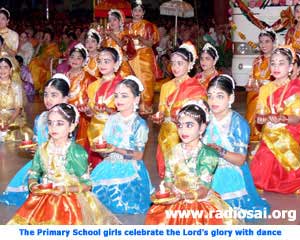 Kavitha Subramaniam began her recital with the famous song, “Janam Diya Tune Sai Ko …”, about Mother Easwaramma because of whom we have the Lord in our midst. A few of her other songs were – “Mein Aayi Thi Darshan Paane …” (I came for your darshan …), "Meine Prem Ki Jyoti Jalayi …" (I lit the lamp of love …) and also the ever famous number "Dhanyabaag Seva Ka Avsar Paya …" (I won an opportunity to do service, I am extremely grateful …). She also sang some bhajans -“Nanda Nandana Hari Govinda Gopala …”, “Raghupati Raghava Raja Ram …” and “Antaranga Sai Anatha Natha Sai …” Her soulful and mellifluous voice has a surreal quality that makes one dissolve totally in the music and forget mundane body consciousness.
Kavitha Subramaniam began her recital with the famous song, “Janam Diya Tune Sai Ko …”, about Mother Easwaramma because of whom we have the Lord in our midst. A few of her other songs were – “Mein Aayi Thi Darshan Paane …” (I came for your darshan …), "Meine Prem Ki Jyoti Jalayi …" (I lit the lamp of love …) and also the ever famous number "Dhanyabaag Seva Ka Avsar Paya …" (I won an opportunity to do service, I am extremely grateful …). She also sang some bhajans -“Nanda Nandana Hari Govinda Gopala …”, “Raghupati Raghava Raja Ram …” and “Antaranga Sai Anatha Natha Sai …” Her soulful and mellifluous voice has a surreal quality that makes one dissolve totally in the music and forget mundane body consciousness.
After this soul-stirring performance, the girl students of the Primary School gave a dance performance to a song that described the beautiful facets of the their Lord, His love and His compassion and Glory. At the end of their performance, Bhagavan posed for photographs with the Primary School Band group.
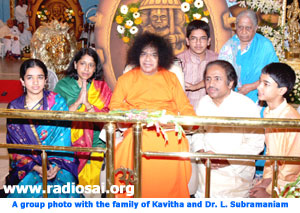
Afterwards Bhagavan talked with Kavitha's entire family and even made a ring for Dr. Subramaniam and also posed for group photos with the family. Bhagavan also recognised the contributions of the photographers who capture all these moments for posterity by personally distributing prasadam out of His divine hands to one and all.
Then all eyes were riveted to the bus 'Sri Sathya Sai Mobile Clinic' stationed in the back of the Hall, as an announcement was made that it was an air-conditioned bus with state-of-the-art medical equipment for treatment.
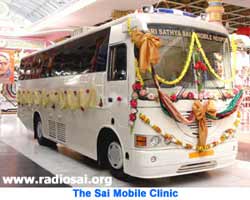 The bus contains an X-ray unit, ultra sound scanner, automatic film processor, Schiller ECG machine, a semi-automatic chemistry analyzer, a binocular microscope, ophthalmoscope, otoscope, retinoscope, foldable simple table for x-ray, foldable screen with stand and an LCD projector.
The bus contains an X-ray unit, ultra sound scanner, automatic film processor, Schiller ECG machine, a semi-automatic chemistry analyzer, a binocular microscope, ophthalmoscope, otoscope, retinoscope, foldable simple table for x-ray, foldable screen with stand and an LCD projector.
These are only some of the sophisticated equipment in the bus for providing advanced medical treatment to patients who do not even have the wherewithal to come to the nearest Hospital.

NOV 20th EVENING: THE SAI INTERNATIONAL CHOIR
November 20th was the first day of the 8th World Conference. In the evening, all the delegates and the devotees who had gathered in the "packed to overflowing" Sai Kulwant Hall were treated to an aural treat in the form of the Sai International Choir.
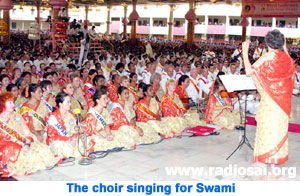 175 members from 45 countries had put in hours of practice over the past few days to blend their voices in perfect harmony to produce mellifluous music that touched everyone's hearts.
175 members from 45 countries had put in hours of practice over the past few days to blend their voices in perfect harmony to produce mellifluous music that touched everyone's hearts.
They started with the rousing number called "The Feast (Swami we celebrate your birthday)" followed by "Rejoice for Lord Sai is Here". This was followed in quick succession with the following numbers - "Yakanaka", "The day You touched my heart", "Eighty years with us", "Sai Mother/Baba Father", and "Carry the Light".
They ended the concert with "Celebrate", "We wish you a Happy Birthday" and for the finale "Heaven invites you to a party". The audience gave these musicians a thunderous ovation for the enchanting afternoon of music. Swami asked the conductor Ms. Alma Badings to continue with the music and the choir responded by singing the two numbers - "Carry the Light" and "Celebrate" again to the delight of the crowd.
NOV 21st: VIP VISITS, DISTRIBUTION OF SAREES TO LADIES AND A CONCERT BY THE SAI SYMPHONY ORCHESTRA
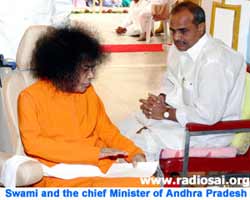 In The Morning
In The Morning
In the morning the Ashram had some important visitors. The Honorable Chief Minister of the State of Andhra Pradesh, Sri Y. Rajasekhara Reddy along with Smt. Geeta Reddy, Minister for Tourism and the Anantapur District Collector, Smt. Y.V. Anuradha called on Swami just ahead of His Birthday.
After giving Darshan to the large crowd assembled in Sai Kulwant Hall, Swami granted them an audience and spent over a half-hour talking with them in the interview room.
In The Afternoon
In an unexpected move, Swami after He arrived to Sai Kulwant Hall for the afternoon darshan started calling numerous ladies to the veranda. Everyone was perplexed wondering what was going on. 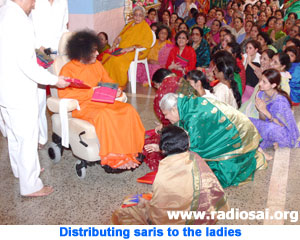
As the number of ladies began to grow, it soon became clear. He was going to distribute saris to the "chosen ones". After Swami was satisfied, mounds of gorgeous saris were carried to the veranda by the student helpers. Swami with His Own Divine Hands handed one sari after another to each one of these ladies, thus blessing them profusely.
After He had finished distributing the saris to these ladies, He even went around the entire ladies enclosure, picking out even more ladies that He wanted to give saris to, so that they could wear it for His birthday.
After this delightful experience of watching Swami enthusiastically give saris to so many ladies, we had a further treat in store. A group of musicians from around the world were dressed up in their "penguin suits" waiting and ready to perform and regale the Lord.
With Bhagavan's Grace, these musicians from around the world came together to perform as one a concert in the Divine presence on Monday, the 21st of November, 2005 , as part of the 80 th Birthday celebrations.
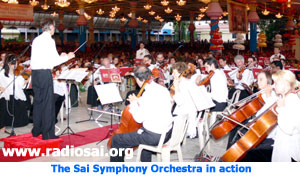 Taking as a theme Swami’s instruction “Love is one, live in love!” given on His Ladies' Day Discourse 2005, the 53 musicians from over 20 countries in Asia, Australia, Europe, North, Central and South America worked together during five days of rehearsals in a joyful spirit of unity and love so that they could perform their best before their Sweet Lord.
Taking as a theme Swami’s instruction “Love is one, live in love!” given on His Ladies' Day Discourse 2005, the 53 musicians from over 20 countries in Asia, Australia, Europe, North, Central and South America worked together during five days of rehearsals in a joyful spirit of unity and love so that they could perform their best before their Sweet Lord.
Before the concert began, Swami blessed Swiss conductor Klaus Maurer with the materialization of a ring. The programme began with Hungarian Dance No.1, written by German composer Johannes Brahms. The piece captures the spirit of the power of the Hungarian spirit. Moving to Italy , the next work was the overture from Gioacchini Rossini’s opera Gazza Ladra, a musical story about a bird, the thieving Magpie. Returning north to Hungary and the music of pianist and composer Franz Liszt, often called the “God of the piano,” the orchestra played his Hungarian Rhapsodie No. 2. Liszt wrote this piece as a tribute to his motherland. Moving west to France , and the music of composer George Bizet, the next two selections were from Bizet’s opera Carmen. Aragonaise, and the Toreadors, or the bullfighters are music brimming with courage and bravery.
Next was the waltz Ainsi que la brise (Just as the light Breeze) by French composer Charles Gounod. This piece reaches out to the Divine in nature, glorifying the wind, and making the countryside resound with a joyous celebration of God. This piece was followed by the 1 st movement of Symphony No.40 in G minor by Austria composer Wolfgang Amadeus Mozart. The orchestra played this work as a praying of yearning to God. Next was Romanian Rhapsodie No.1 Op.11 by Romanian composer George Enescu. Enescu has been called “the most amazing musician since Mozart.” In this Rhapsodie, with its tremendous energy, emotional depth, and forward momentum, we Sai devotes can hear the power of our beloved Swami. There is nothing that can stop the unfolding of His Divine Mission for the transformation of entire mankind! 
The concert concluded with a musical call to action. The musicians called upon all devotees to take up the weapons of truth, unity, purity, divinity and love. With these silent weapons, they urged all to march forward fearlessly and invincibly as soldiers in the Sai Global Army, the Sai army of “Love in Action.” In this spirit, the orchestra played the inspirational Light Cavalry by Italian composer Franz Suppé.
The piece depicts soldiers on horseback charging courageously into battle. At the programme’s conclusion, Bhagavan brought so much joy to the musicians by inviting them to gather around his chair on the portico for about 15 minutes of informal and intimate conversation, the cherished group photos, and the materializations of rings for two more musicians. This exhilarating time with Swami was truly a celebration of “Love in Action!”

NOV 20th AND 21st: A REPORT ON THE 8TH WORLD CONFERENCE OF THE SRI SATHYA SAI ORGANIZATIONS
Every five years in conjunction with Swami's Birthday, a World conference of the Sri Sathya Sai Seva Organizations is held in Prashanti Nilayam. The first World Conference was held on 1st May 1968 and has since then grown phenomenally.
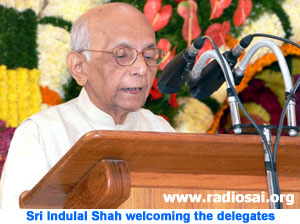 This year for the 8th congress more than 10,000 delegates from India and about 3000 delegates from over 120 countries participated and deliberated about the future course and direction of the Organization.
This year for the 8th congress more than 10,000 delegates from India and about 3000 delegates from over 120 countries participated and deliberated about the future course and direction of the Organization.
The Inauguration of the World Conference was held in Swami’s presence in Sai Kulwant Hall on the morning of the 20th of November. Sri Indulal Shah welcomed the delegates and expressed gratitude to Swami for the grace and love He has showered on them.
He talked about the changes in the Sai Organizations since the first world conference in Bombay in 1968 - the Organization has grown to over 5000 Sai Centres in India alone and to 2200 Sai Centres in over 180 countries outside India. Sri Indulal Shah also discussed Bhagavan’s vision of a world transformed, with Sai in the hearts of all and outlined the tasks before the organization that have to be addressed.
Thereafter, Sri V. Srinivasan, All India President of the Sathya Sai Organizations of India, expressed gratitude to Bhagavan on behalf of all the delegates for all He had done to make their stay in Prashanti Nilayam pleasant. He spoke about the organization's activities in India and its growth over the years because of Bhagavan's Grace.
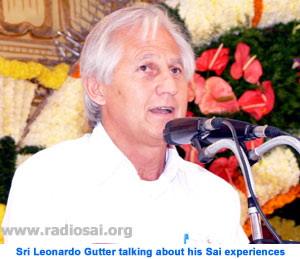 Dr. Michael Goldstein, Chair of the Prashanti Council and Chairman of the International Sathya Sai Organisation, ended the inaugural proceedings eloquently by talking about the theme of the conference: Unity, Purity and Divinity. He mentioned that Unity, Purity, and Divinity were not three distinct things but three stages in our spiritual path. At the end of the path, we would experience what we really are - a personification of Love.
Dr. Michael Goldstein, Chair of the Prashanti Council and Chairman of the International Sathya Sai Organisation, ended the inaugural proceedings eloquently by talking about the theme of the conference: Unity, Purity and Divinity. He mentioned that Unity, Purity, and Divinity were not three distinct things but three stages in our spiritual path. At the end of the path, we would experience what we really are - a personification of Love.
Bhagavan then called Sri Leonardo Gutter of Argentina and asked him to address the audience. Sri Gutter thrilled the audience by speaking feelingly from his heart and relating his personal experiences of Bhagavan's omnipotence, omnipresence, and omniscience.
Due to space and logistic considerations, the World Conference proceeded with the international organization having their own conclave and the national (Indian) organization meeting separately in Sai Kulwant Hall to discuss the conference theme.
THE INTERNATIONAL CONFERENCE
Three thousand foreign delegates from 120 countries came to Prashanti Nilayam to take part in the two-day 8 th World Conference of the International Sai Organizations. The Conference of foreign delegates took place in a huge tent set up behind the North Block residence complex. Six talks were given, all discussing Unity, Purity, and Divinity in the context of some aspect of the Sai Organization.
Dr. Narendra Reddy, member of the Prashanti Council and Chair of the International Medical Committee, talked about the devotion wing. His main message is that unity, purity, and divinity can be reached only through love. Everything about Swami —His life, His message, His Ideals— is Love. He touched on ways Swami has taught us to develop and express Love and spiritual evolution and talked about signs of devotion, mentioning experiencing peace and equanimity and desiring to show Love through service.

Anil Kumar, Professor of Botany at the SSSIHL, in his inimitable manner kept the delegates on the edge of their seats in discussing Unity, Purity, and Divinity in the context of education. His main message is that we should imbue education with Educare which means bringing out the latent divinity in a human being and establishing it as an ideal to the whole world. He discussed the difference between education and Educare by saying that while education will make you an intellectual, Educare leads to intelligence and wisdom; education deals with the physical world, while Educare is the subjective inner reality; and that education is conscience, while Educare is consciousness.
Retired Chief Air Marshall Sri N.C. Suri talked about selfless service. He indicated that we could progress along the stages of Unity, Purity and Divinity through service. He made the point that religions tend to separate us and suggested that we begin saying prayers from all religions to break down barriers. There is only one God - take that message everywhere he said.
Sri Shitu Chudasama, the UK Youth Coordinator, discussed the Young-Adult Program of the Sai Organization. He mentioned that since the well-being of the world depends on our youth, the Sai Organization must provide circumstances in which Unity, Purity, and Divinity can manifest in the youth of the organisation. Devotion, education, and service programmes must involve all the Sai Youth to bring their enthusiasm, creativity, and courage into the organization in a way that promotes the development of selfless love.
Sri Narasimha Murthy, Warden at the Brindavan Campus of the SSSHIL and author of the fifth volume of Sathyam Sivaram Sundaram, spoke about the Sai Ideal Devotee, showing a depth of understanding that has come through years of faithful work for Swami. He related some interesting personal stories of his relationship with Swami. He talked about four qualities of an ideal devotee: (A) Awareness of the unsullied joy and selfless love that lies within each of us. (B) Balance of mind —equanimity. (C) Control over the mind and senses. (D) Dedication to the Sai Mission.
A high point of the Conference was the question-and-answer sessions, with panels consisting of Sri Michael Goldstein; Sri Bill Harvey, member of the Prashanti Council; Sri Anil Kumar; Sri Narasimha Murthy, Sri Narendra Reddy, and Air Chief Marshal Suri. Delegates submitted over 300 questions and comments covering a wide range of topics —cultural issues within Sai Centres, education versus educare, results of the subcommittee that reviewed all aspects of education, guidelines of the Sai Organization, service, spiritual questions, and so on. Some of these were discussed during the question-and-answer sessions, and all of them will be addressed in communications to Sai Organizations at a later date.

THE INDIAN CONFERENCE
The Indian Organisation held its deliberations in the Sai Kulwant Hall on November 20 and 21st. The first session on November 20th addressed the theme of the conference in relation to the Individual and the Family. It covered the following:
a. What Unity, Purity, and Divinity means to the Individual and the Family.
b. The Inner Significance of Unity, Purity and Divinity for the Individual and the family.
The second session of the Indian Conference on November 21st broadened the theme of the conference to include the Organisation and Society. It covered:
a. What Unity, Purity, and Divinity means to the Sai Organisation and its members.
b. The importance of Unity and Purity for the Organisation.
c. The inner Significance of Divinity for the Organisation.
The huge crowd of 10,000 delegates that had gathered in Sai Kulwant Hall were addressed on these issues by an eminent panel of speakers. They included Sri S. V. Giri, Sri G. Venkataraman, Sri Narasimhamurthi, Sri Anil Kumar, Sri Anjanaiah, Sri Nimesh Pandya, Dr. Narendranath Reddy, Sri Keki Mistry and Sri Ajith Poppat.
Not wanting to make this already long report even longer, instead of reporting the summary descriptions of their talks we will carry them in full over Radio Sai. We hope you will listen in on the talks by these speakers and benefit from their experiences also.
The Indian conference has formulated a series of recommendations, which will be further discussed by each State of India in their own State conferences and then decisions will be taken for implementation.
Thus after two days of hectic deliberations the 8th World Conference came to a close so that the delegates could enjoy and savour in full what they all had been looking forward to all year - the celebration of the 80th year of the advent of the Avatar.
NOV 22nd EVENING: XXIV CONVOCATION OF THE SRI SATHYA SAI INSTITUTE OF HIGHER LEARNING
The Convocation Function
The 24th Convocation of Sri Sathya Sai Institute of Higher Learning was held in Sai Kulwant Hall on the afternoon of 22nd November 2005. The Hall was filled with students, their parents, relatives and well-wishers of the Institute as well as the many devotees who had come from far and near to attend Bhagavan's 80th Birthday celebrations. 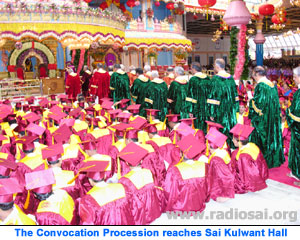
Sai Kulwant Hall was elaborately decorated for the occasion with multi-hued flowers intertwined with thick green foliage being draped over all the columns of Sai Kulwant Hall. The temple façade was also richly decorated with floral patterns and a floral arch adorned the Ganesha statue at the centre of the dais. The steps in front of the veranda were laid with a lawn interspersed with bright flowers to give the whole stage the appearance of a garden setting.
The dais was aesthetically arranged with the Chief Guest and the Chancellor's seat as the centre-piece. The other dignitaries sat on raised platforms behind this central arrangement. All the chairs were neatly labeled with the names of the dignitaries.
The procession comprising the Chief Guest Hon’ble Sri T.N. Chaturvedi, Governor of Karnataka; the Chancellor, Bhagavan Sri Sathya Sai Baba; the Vice Chancellor, Sri Anil Vinayak Gokak; Distinguished Guests, Members of the Institute Trust, Members of the Governing Body, Dean of Faculties and Members of the Academic Council began its march from the Poornachandra Auditorium at 2.45 p.m. to Sai Kulwant Hall. The Institute brass band led the procession with the Registrar of the Institute bearing the Institute Mace, while two students carrying the Emblem of the Institute joined the procession on either side of the Registrar. After the procession reached the dais and the dignitaries had taken their seats, a group of students from the Institute chanted the traditional invocatory chants which exhorts to follow truth and righteousness and revere the mother, father, preceptor and guest as God. Then the Revered Chancellor, Bhagavan Sri Sathya Sai Baba declared the Convocation open.
 |
|
The Vice Chancellor in his introductory speech welcomed the chief guest and the members of the Institute. The candidates for various degrees and Post Graduate Diploma were then presented to the Revered Chancellor by Prof. U.S. Rao, Principal of the Institute. At the behest of the Vice Chancellor, candidates to whom Degrees have been conferred repeated the following pledge after the Vice Chancellor.
“I hereby solemnly declare and promise that, if admitted to the Degree for which I have been duly recommended, I will, in my daily life and conversation and in thought, word and deed, conduct myself as befits a member of Sri Sathya Sai Institute of Higher Learning; that I will, to the utmost of my capacity and opportunity, support the cause of sound learning, humanity, morality and spirituality; and that, as far as lies in me, I shall uphold and advance the social and, indeed, all round welfare of my countrymen and fellowmen.”
|
|

The names of the medalists who had achieved distinction in their respective disciplines were then read out by the Principal. The Sri Sathya Sai All Round Gold Medal was awarded to Sri Srikant Khanna, an M.Tech. (Computer Science) student, who had shown exemplary conduct and behaviour and excelled not only in studies but also in sports and co-curricular activities during his years of study at the Institute.
17 other students who achieved distinction in their respective disciplines also received their gold medals from the Divine hands and quickly posed for the coveted photo with Bhagavan.
The Chief Guest in his address praised the system of free education prevalent in Swami's educational institutions. He said,
"Bhagavan’s benedictory addresses constitute a rich corpus of knowledge and wisdom on which the entire philosophy of education emerges. Sri Sathya Sai Baba has given us the remarkable concept of integral education; it is integral to our cultural and spiritual heritage; it is integral to the dynamics of modern times; it takes a holistic view of education. For Baba, education signifies the total development of man.
Baba believes that quality in education has to be maintained but opportunities have to be provided for those who are bereft of them. He does not believe in levelling down but in levelling up. Excellence ought not to be the privilege of a select few. Hence, free education and the expansion of opportunities without any sort of differentiation. Baba wants to democratize excellence by providing avenues to those with talent and potential." |
|
|
After the Chief Guest’s Address, Bhagavan graciously consented to deliver His Benedictory Address. Bhagavan said in part,
"Education should enable one to cultivate good qualities, character and devotion. When there is unity between thought, word and deed, one can acquire purity and realise divinity. Modern education is fully self-centred. Contrary to it, true education teaches selflessness. People pursuing such type of education, give up their selfish interests and work for the larger interest of society.
It is said, 'Paropakaraya punyaya, Papaya parapeedanam' (one attains merit by serving others and commits sin by hurting them). Wherever you see, people today analyse whether a particular activity they wish to undertake will bring material benefit to them or not. People tend to forget that the real self is one’s own Self (Atma), which is the same Self (Atma) present in every individual. And, that Self is Chaitanya Shakti (the power of universal consciousness). This Chaitanya Shakti is present in every human being, nay every living being. That is why it is said, 'Easwara Sarva Bhutanam' (God is the in-dweller of all beings).
|
|
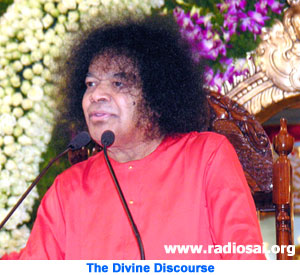 |
Education is not for earning a fat pay-packet. It may perhaps help us to acquire name and fame and build palatial buildings with modern comforts. But, devoid of character, of what use are all these comforts? Unfortunately, today the world only respects such people.
Man loses peace on account of developing attachments. Man has everything – good food, comfortable life, etc. but, he has no peace of mind. Why? Because, he has developed an attachment to the objects of enjoyment. Peace depends upon one’s attitude to life and living. Hence one has to develop Ekatma Bhava (feeling of oneness). If this Ekatma Bhava is developed, one can move about freely in the world with no attachment to any particular individual or object.
Today, trash literature is found everywhere. Wherever you see, you will find people, especially youngsters reading bad books that pollute their minds. You might have observed youngsters visiting the library invariably on Sundays and holidays. They search for bad books and read them with absorbing interest. Those bad books are very exciting to the young minds. Thus, youngsters spoil themselves on account of bad company. No force on earth can change such boys. Not even God. "
Then the entire congregation rose to sing the National Anthem and thus brought this formal function to a close.

The Convocation Drama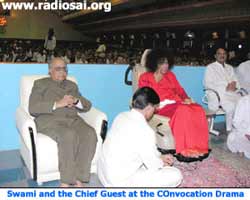
Following the Convocation function, the students stage the convocation drama in the Poornachandra Auditorium. A lot of effort goes into its preparation and strict secrecy is maintained regarding the theme of the drama in order to maintain the surprise factor and enhance its impact on the audience.
This year's drama was called Prem ki Jyoti or "The Light Of Love" and started a little after 6 P.M. after Bhagavan had taken His seat in the Poornachandra Auditorium.
In the picture on the right, you see Swami sitting in the Auditorium and the Chief Guest beside Him watching the Drama.
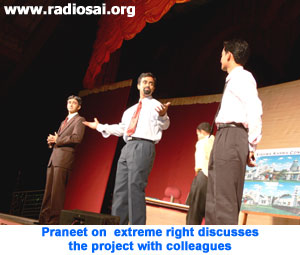
Vishwakarma Constructions, a mega project construction company has won a prestigious contract to build the largest Sarva Dharma temple by under-bidding and have narrowed the location to 2 sites. The more cost effective one is on level land but would involve evicting 500 families, who though squatting illegally are still the poorest of the poor and totally destitute.
The conscience stricken architect, Mr. Praneet Kumar convinces his associates (the Managing Director Mr. Christopher Sabien, the Finance Officer Mr. Anwar Aziz and the Materials Manager Mr. Vijay Saxena) to go with the more expensive route of levelling a hilly tract and not evict these poor people, by explaining that God will help them out of this situation.
True to form, the labourers volunteer two hours of free service helping to cut labour costs.
 However, troubles soon appear. Mr. Praneet starts behaving indifferently and soon resigns to the anger of his associates. Without a good architect, the project is behind schedule and costs shoot way over the budget. Cement prices also skyrocket and soon the company is in dire financial straits. At this juncture, Mr. Saket Sharma, a world famous architect, offers his services free of cost to this noble cause and his genius brings the costs down to manageable levels.
However, troubles soon appear. Mr. Praneet starts behaving indifferently and soon resigns to the anger of his associates. Without a good architect, the project is behind schedule and costs shoot way over the budget. Cement prices also skyrocket and soon the company is in dire financial straits. At this juncture, Mr. Saket Sharma, a world famous architect, offers his services free of cost to this noble cause and his genius brings the costs down to manageable levels.
Astonishingly, Mr. Santosh Kumar, a cement dealer is also moved by the nobleness of the project to offer them cement at cost, thus helping them to complete the project within the budget and keep the company solvent.
On the opening day of the temple, Mr. Saket Sharma, Mr. Santosh Kumar and the laborers all reveal that they had all been inspired to perform their philanthropic act of offering their services free by Mr. Praneet Kumar.
Mr. Sharma further shocks everyone when he reveals that Mr. Kumar has contracted a deadly disease and does not have much time to live. At this the animosity of his associates towards Praneet disappears and they pray for his recovery.
In the climax scene, Praneet Kumar comes to the stage to the joy of all his friends. He explains his disappearance by saying that he had gone to Puttaparthi to get Swami's blessings for the construction of the temple. Pointing at his heart, Swami had told him, "This is my real temple. You have given your everything for that temple, and I shall infuse new life into this temple - His true temple". A fully cured Praneet thus comes for the opening day ceremony.
The boys neatly brought out the theme that the body is the true temple of God; and good work is eventually rewarded in spite of initial hiccups; finally they also expressed that the need of the hour is Sarva Dharma Samamvaya or the unity of all religions.

NOVEMBER 23rd: HIS 80th BIRTHDAY!
The Morning Function
After all the planning, after all the preparation, after all the year long programmes and celebration the BIG day was finally here!!
The day broke early but the sky being overcast caused an initial pall over the proceedings. It had been raining for the last couple of days, but the inclement weather did not deter the devotees from assembling into the decorated stadium well before the break of dawn to get vantage positions for the blissful darshan of the Lord on this most auspicious of days. This day marks the 80th year of sojourn of the Lord in His Human Form on this earth; a descent undertaken solely for the benefit of humanity. Variously described as 'the Avatar of the Age', 'Love walking on two legs' and 'an Ocean of Compassion', the Lord who has always been and always will be, goes through this mundane business of celebrating "birthdays" solely for the pleasure that it gives us - His devotees!
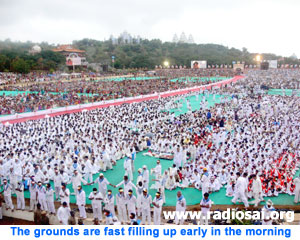 A lot of preparation had gone in to make the viewing comfortable for the thousands of assembled devotees in the Stadium. Two big "Cricket Stadium" style viewing screens had been kept at vantage points to display the "live action" for everyone's benefit. These big screens obtained their feed from a network of 8 video cameras that were strategically located to capture all the nuances, of all the action, on the dais and elsewhere in the Stadium.
A lot of preparation had gone in to make the viewing comfortable for the thousands of assembled devotees in the Stadium. Two big "Cricket Stadium" style viewing screens had been kept at vantage points to display the "live action" for everyone's benefit. These big screens obtained their feed from a network of 8 video cameras that were strategically located to capture all the nuances, of all the action, on the dais and elsewhere in the Stadium.
A special high stage had been constructed on the hill side in the Western end of the stadium, near the statue of Lord Shiva so that everyone could view the proceedings unhampered. The Shanti Vedika had undergone an entire makeup with a tile floor being laid and other amenities being constructed to make the structure more user-friendly. Huge banners were hung strategically with mammoth photos of Bhagavan.
The entire stadium floor was covered with a green waterproof carpet for the devotees to sit on, so that the wet conditions would not cause discomfort. Contrary to previous years when Swami would enter the stadium from the far West side near the ladies enclosure; this year the stadium was bisected by a red carpet in the middle through which Swami's car would pass - thus according everyone in the Stadium a good view of Swami. Balloon bunches were tied at various points for release on Swami's entry. The entire place was glistening with a fresh splash of paint. The Hanuman statue and even the Administration Block and the Museum in the North side of the stadium were lit up giving the place an enchanting look right out of fairyland.
Soon a tension filled the stadium. Word had come that Swami had left Poornachandra. The Lord entered the stadium in all His Majesty in an open car at 7:40 AM , to a very fitting welcome by Sai Gita - His pet elephant. He was lead into the stadium in a grand procession lead by Sai Gita, the Veda Chanting students, followed by a group of dancing students in colourful costumes and all the Band squads from the campuses of the Sri Sathya Sai Educational Institutions. Continuous bursting of daytime crackers heralded His arrival. 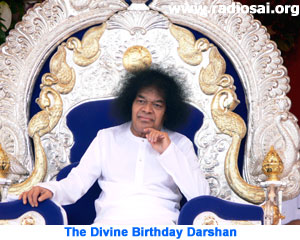
Confetti streamed all over the stadium. A pleasant welcome song hailing His advent provided the back-drop for His grand entry. Balloons were released and everyone was agog with excitement, continuously craning their necks to etch this momentous moment forever in their consciousness.
Soon He reached the stage and took His place on the high-backed silver throne and gave His glorious birthday darshan to the entire multitude. Looking resplendent in His white robe, He smiled benevolently at everyone, as innocently and as excitedly as a young school boy full of innocence and charm!
It was a sight fit for the Gods, and surely the denizens of Heaven would also be looking down, hailing the supreme Lord Narayana in His 80th year of advent on planet Earth.
 Perhaps at His signal, the festivities soon began - first with a Amala Shankar & troupe welcome dance on the specially constructed stage. All eyes were still riveted on the Lord and it was difficult to tear the eyes away even to just peek at the dancers on the stage. Next on the agenda were contingents from 4 countries that marched past Shanti Vedika to hail the Lord on His Birthday while the specially prepared birthday song played in the back-ground.
Perhaps at His signal, the festivities soon began - first with a Amala Shankar & troupe welcome dance on the specially constructed stage. All eyes were still riveted on the Lord and it was difficult to tear the eyes away even to just peek at the dancers on the stage. Next on the agenda were contingents from 4 countries that marched past Shanti Vedika to hail the Lord on His Birthday while the specially prepared birthday song played in the back-ground.
There were two Masters of Ceremonies - Sri Sai Kumar (a Telugu film star) who compeered in Telugu and eulogized the Lord on His Birthday. Sri Sunil Gavaskar ("The Little Master") a well known cricketer of yesteryears was the English MC and he paid his respects to Bhagavan on everyone's behalf. Col. Rajyavardhan Singh Rathore, a rifle shooter from India and a Silver Medalist at the 2004 Athens Olympics, was one of the guests at the morning function.
There were also some unexpected but very welcome visitors in this cricket mad country - a few members of the current Indian cricket team. There was master blaster Sachin Tendulkar, a favourite who received a roar of welcome from the crowd. Along with Sachin were Yuvraj Singh , R. P. Singh, V.V.S. Laxman, Murali Karthik, J.P.Yadav, Suresh Raina, and emerging fast bowler Sreeshant, all of whom had come in a special bus from Bangalore.
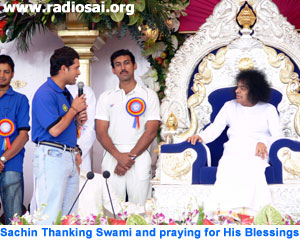 Then, Sri Sunil Gavaskar, the Master of Ceremonies, invited Maj. Rajyavardhan Singh Rathore to hoist the Global Peace Insignia for the well being of humanity. After receiving Bhagavan's blessings Maj. Rathore took the insignia out of Shanti Vedika and ran up to the specially erected stage like an Olympic torch bearer and then showed the logo to the enormous gathering before it was finally hoisted up the hill to the highest point of the stadium near the Hanuman Statue. …And then the 80th birthday message was unfurled down the hill slope - “May there be Peace, Unity and Love in the World”.
Then, Sri Sunil Gavaskar, the Master of Ceremonies, invited Maj. Rajyavardhan Singh Rathore to hoist the Global Peace Insignia for the well being of humanity. After receiving Bhagavan's blessings Maj. Rathore took the insignia out of Shanti Vedika and ran up to the specially erected stage like an Olympic torch bearer and then showed the logo to the enormous gathering before it was finally hoisted up the hill to the highest point of the stadium near the Hanuman Statue. …And then the 80th birthday message was unfurled down the hill slope - “May there be Peace, Unity and Love in the World”.
Streamers were also rolled down the hill and the global birthday party at which the entire world was present was well underway! All the cricketers presented Bhagavan with bouquets and obtained His blessings. In a brief speech Sachin Tendulkar expressed happiness on behalf of all the cricketers and said that they felt extremely honoured to be present at His 80th Birthday celebration. He also sought Bhagavan's blessings for the entire cricket team.
 The first speaker for the session was Sri Indulal Shah, formerly World Chairman of Sri Sathya Sai Organisations, and currently Advisor to the Prashanti Council, the overseeing body for the Overseas Sathya Sai Organisations. Mr. Shah while offering his prayerful salutations at His Lotus Feet said,
The first speaker for the session was Sri Indulal Shah, formerly World Chairman of Sri Sathya Sai Organisations, and currently Advisor to the Prashanti Council, the overseeing body for the Overseas Sathya Sai Organisations. Mr. Shah while offering his prayerful salutations at His Lotus Feet said,
"For over 40 years I have been witness to the birth and growth of the Sathya Sai World Organisation, which I feel is the greatest gift from Bhagavan for experiencing the divinity within. The message of love has spread across countries and cultures, religions and races to teach mankind the importance of good thoughts, words and deeds. We are led to believe that the era of worldwide peace is here for us to experience. The Avatar has two hearts: one bleeds for our pain, the other forbids our folly. Unless we share a little of these hearts in our own hearts we can not be included in His mission".
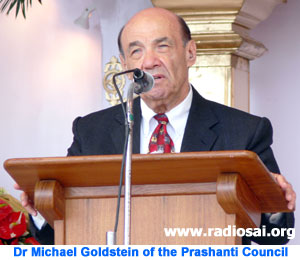 He further added that Bhagavan’s Message of Love is beyond countries, culture, religion and race and it is time for all of us to blend into a Brotherhood of Mankind.
He further added that Bhagavan’s Message of Love is beyond countries, culture, religion and race and it is time for all of us to blend into a Brotherhood of Mankind.
Dr. Michael Goldstein, Chairman, Prashanti Council, in his exhilarating speech highlighted that the era of peace is here for us to experience. In his own words,
"He is fathomless, never ending selfless love. He is our divine mother and father. He is the saviour of His own creation. He is the Kaliyuga Avatar.
One day I had the temerity to ask Swami to permit me to see a glimpse of the world through His eyes. Swami smiled condescendingly and He deigned to answer my question and said, 'If I let you see you will not want your job, your house, family or body. And if you see for more than a few seconds you will be gone.'”
At the end of his speech, Dr. Goldstein prayed to Bhagavan to bless the huge concourse of devotees with His Divine Benedictory Message. In His Divine discourse, Bhagavan highlighted the importance of Sathya, Dharma, Shanti and Prema in one’s daily conduct. These seminal values should permeate one’s conduct from dawn to dusk. Swami said,
"We must realise that we are born to experience our innate divinity and not merely to enjoy worldly pleasures. We have to take to the path of spirituality to experience our innate divinity. If we lack in spiritual outlook, we do not deserve to be called human beings. In fact, it amounts to betrayal of God. God does not expect you to worship Him. He expects you to lead an ideal and purposeful life.
Who is God? In fact, you yourself are God. Hence, everyone should develop the firm conviction, “I am God”. When you develop such firm conviction, there will be no room for ego and hatred. You are God and your fellow human being is also God. Develop such principle of oneness and equality. When you harm others, you actually harm yourself. Victory and loss are a part of the game of life.
|
|
 |
You may criticise someone as a bad person today and extol him as a good person tomorrow. Good and bad are your own thinking. Your mind is the cause for both. In reality, man is always good by nature. Human life is highly sacred. That is why it is said, Daivam manusha rupena. Do not belittle yourself thinking that you are a mere mortal. You are verily God Himself. The very fact that you portray God in a human form and worship Him proves that human being is essentially divine. Do not attach undue importance to names and forms. Understand the inherent principle of divinity.
You may ask, “Is there anyone without worries and desires?” I am Myself the living example in this regard. I have absolutely no desires whatsoever. Everything is in My hand. I can give you whatever you ask for. However, do not crave for materialistic things from Me. They are transient like passing clouds. Ask for that which is eternal. The entire world is sustained by the twin principles of truth and love. They are present in everyone. I am the truth that is present in all. I am the love that is present in all. Truth and love are all-pervasive. However, you are not making efforts to experience truth and love".
He also expressed His joy at the vast concourse of humanity that thronged the Sri Sathya Sai Hill View Stadium and blessed them to enjoy a long, peaceful and happy life. People would derive real ananda by practising His teachings, emphasised Bhagavan.
Dignitaries who attended the morning function included His Excellency the Governor of Andhra Pradesh, Sri Sushil Kumar Shinde; His Excellency the Governor of Karnataka, Sri T.N.Chaturvedi; the Hon’ble Chief Minister of Maharashtra, Sri Vilasrao Deshmukh; the Hon’ble Finance Minister of Andhra Pradesh, Sri Rosaiah; the Hon’ble Minister for Tourism and Sugar of Andhra Pradesh, Smt. J. Geeta Reddy and the Former Chief Minister of Andhra Pradesh, Sri N. Chandra Babu Naidu, along with many other local and State Government officials.
After His Divine Discourse Bhagavan cut an oversized cake and lit a candle on the cake and also personally distributed the prasadam of laddus to the members of Indian Cricket Team and some of the dignitaries present. He had a special word for everyone and profusely blessed the entire gathering before He left the Hill View Stadium after mangal arathi.

The Afternoon Function
While the formal birthday function was over in the morning, the gaiety and fun was reserved for the afternoon.
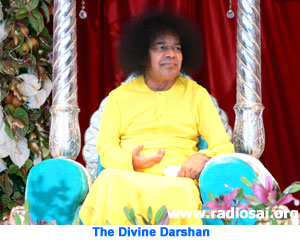 Swami came to the Stadium in the afternoon in an open car but now in a bright yellow robe, looking like Sai Krishna. Swami was led to the stadium by a long procession of performing artistes from the different States of India.
Swami came to the Stadium in the afternoon in an open car but now in a bright yellow robe, looking like Sai Krishna. Swami was led to the stadium by a long procession of performing artistes from the different States of India.
The first group in the procession was a folk dance troupe from Tamil Nadu, followed by a garba dance group from Gujarat, folk dancers from Orissa and the Sangli district of Maharashtra, kavadi dancers from Kerala, the nadaswaram troupe from the Anantapur Campus, Pipers from the Primary School, the Anantapur Campus Band, the Primary School Band, the Institute brass band and bhangra dancers from the Primary School.
After arriving on stage, Bhagavan sat in the beautiful golden-hued throne for the programme. This throne was smaller in size than the morning's but had an umbrella at the top in the traditional style.
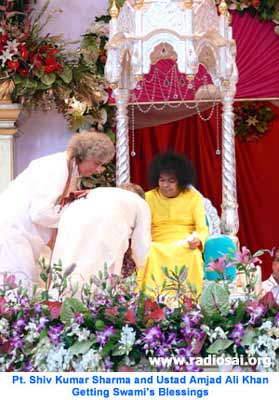 While He sat there giving a feast for everyone's eyes, a welcome was sung in the background with the lyrics “Sai’s Birthday is a festival for Sathya, Dharma, Shanti and Prema. Happy Birthday to You Bhagavan.”
While He sat there giving a feast for everyone's eyes, a welcome was sung in the background with the lyrics “Sai’s Birthday is a festival for Sathya, Dharma, Shanti and Prema. Happy Birthday to You Bhagavan.”
The special stage set up on the western side of the stadium looked magnificent with lights and other decorative paraphernalia. Two renowned artistes of Hindustani music Pandit Shiv Kumar Sharma and Ustad Amjad Ali Khan sought the blessings of Bhagavan in Shanti Vedika before climbing up to the stage to begin their performance.
Sri Sai Kumar compeering the show began by saying that people from all countries and cultures without any barriers of caste, creed, religion and nationality have assembled here in Prashanti Nilayam for Bhagavan’s Birthday. The first to perform was Pandit Shiv Kumar Sharma and his son Rahul Sharma on an instrument called the Santoor. Pandit Shiv Kumar Sharma said that he had the good fortune to perform in the 60th, 70th and now in the 80th Birthday of Bhagavan.
Sri Fazal Quereshi played on the drums and Sri Yogesh Samshi accompanied him on the tabla. The audience was treated to the rich and haunting sounds of the santoor lingering lightly on the cool dusky air of the stadium. The santoor recital ended on a high note with the refrain “Baba, we love you”.
The Sarod maestro Amjad Ali Khan with his sons, Aman Ali Bangash, Ayan Ali Bangash and wife Subbalakshmi gave a scintillating performance. Ustad Amjad Ali Khan said that it was a great opportunity for them to offer a musical tribute to Swami. His second piece Raghupathi Raghava Raja Ram was especially enjoyed by one and all.
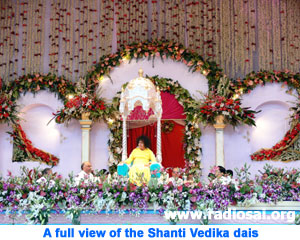
Begum Parveen Sultana, doyen of Hindustani classical music, thanked Bhagavan for this greatest opportunity. Begum Parveen Sultana has been a regular performer on the Birthday afternoon for a few years now.
She began her performance with a composition that her husband and guru Ustad Dilshad Khan had specially composed for the occasion. Her next song was Payoji Maine Ram Ratan Dhan Payo (I have got the precious wealth of the gem of Rama Nama).
She ended her performance with the song Sai Ram, Sai Ram, Sumiran Karoon Sakhala Dukh Haran (the holy name Sai Ram, if chanted removes all types of grief).
 The music programme was interspersed with green streaks of light originating from the hill-side making and breaking green patterns all over the stadium. The laser show had started with appropriate instrumental music in the back-ground, thrilling the rural populace who were seeing such a show for the first time in their lives.
The music programme was interspersed with green streaks of light originating from the hill-side making and breaking green patterns all over the stadium. The laser show had started with appropriate instrumental music in the back-ground, thrilling the rural populace who were seeing such a show for the first time in their lives.
Singing next were Dr. L. Subramanyam and Ms Kavita Krishnamurthy. They had played in Sai Kulwant Hall a few days ago on Ladies' Day. This time however, they were accompanied by 80 students of Institute to sing the chorus. Dr. Subramanyam began with Vathapi Ganapathim Bhajeham, a composition of Muthuswami Dikshitar. Then the special Birthday song composed for the occasion was led by Smt. Kavita Krishnamurthy, in which the students participated. The lyrics of the song ran thus: “We seek Your blessings Bhagavan Sri Sathya Sai Baba, You are the guiding light.”
The celebrated blues singer Ms Dana Gillespie from the U.K. was the next to perform. She sang two songs which enthralled the audience and maintained the fast tempo of the programme:
“What can I give to the One who has everything
Who holds the whole world in the palm of His Hand? …”
And
“With the lamp of love you’ll never be in darkness
If you hold it near, it’ll take you far …”
At the end of Ms. Gillespie's programme, again the laser light show light the night air but this time it was accompanied by a fabulous display of fireworks. The fireworks illumined and streaked across the sky in many hues too grand and spectacular to describe with mere words. These fireworks were even better than the fireworks I have seen in major American cities on the 4th of July. The multihued coloured fireworks light up the night sky to prolonged oohs and aahs from the audience. The primary school children especially were most awe-struck and with the music in the background it made for a very enjoyable time for all.

While these sound and light shows were going on, Ms. Richa Sharma sang a devotional song, urging the audience also to participate and sing along. After Ms. Richa Sharma’s performance, all the artistes went down the stage to seek blessings from Bhagavan. Again there was another display of fireworks. After arati was offered to Bhagavan, He left for His Abode at 7.25 P.M., leaving behind thousands of His devotees who will carry the day's events forever in their memory.
So finally the celebrations of the 80th year of Advent had come to an end. After all the gaiety, and all the fun, and all the celebration we still need to take a moment and ask ourselves a few simple questions. The Avatar has been with us for 80 full years, but have we taken full advantage of it? Have we drunk deep from this Ocean of Wisdom ?
We are also an infinitesimally small part of Him but have spent eternity wandering aimlessly and taking birth and rebirth through the 8,400,000 species of life. Have we even now made a sincere effort to take full advantage of the Avatar's presence, break the bond of maya and regain our divine heritage? Have we made any progress in ridding ourselves of our ego? Have we begun to realize the divinity within and the oneness of all!? Otherwise all this hoopla would just have been mere hype. Let us all resolve that from this 80th Birthday, every moment will be spent in putting into practise all that He has taught us, let that be our birthday gift to Him, to Him Who has given us all.

NOV 25th: A BIRTHDAY FOOT-NOTE: A RUSSIAN LANGUAGE CHOIR AND A SINGAPORE BALA VIKAS DRAMA DOUBLE HEADER PROGRAMME
Even after the completion of the Birthday there were still so many countries that had cultural programmes prepared that Swami on November 25 permitted two programmes to be held in Sai Kulwant Hall - a Russian Language Choir and a Balavikas drama by children from Singapore.
The Russian Language Choir
About 280 devotees (out of a total group strength of 1300) from the Russian speaking countries of Azerbaijan, Armenia, Belarus, Georgia, Kazakhstan, Kyrgyzstan, Moldova, Russia, Tadzhikistan, Turkmenistan, Uzbekistan, and Ukraine gave a concert in the Russian language entitled "Sathya Sai Baba, Our Hearts are singing for you…."
The group of men and women, who were all dressed alike for their opportunity of a lifetime to sing in His Divine presence, sang the following songs in Russian: "Glory to God", "Our souls are full of luminous light", "God is your best friend, God is love", "There is nothing better than Swami coming to us", "Our dearest Sai", "In the luminous light", "Sounds of flute", "Evening Bells", "Sathya Sai Baba, our hearts are singing for you…" and finally "Kalinka".
Their palpable devotion and singing from the heart had everybody clapping their hands and keeping tune. Though the songs were in an alien tongue, still it found resonance with everyone through the language of the heart.
Swami was happy with their performance and also acceded to their prayer for a group photograph with Him.
ATMA NIVEDANA - by The Bala Vikas Students Of Singapore
Following the Russian language choir, the Bala Vikas students from Singapore presented a humble offering to beloved Bhagavan entitled, "Atma Nivedana" based on the story of Bhaktha Pothana, a great poet and devotee of Lord Rama whose life is exemplary of total surrender to God. 
The programme began with a musical performance known as Dikir Barat, a time-honoured Malay art form in which a group of performers sit and sing with synchronized body and hand movements.
The play itself was performed in many parts. The first scene highlights Pothana's attitude of selfless love and service when he gives his own food away to a hungry man. In the next scene Lord Rama entrusts Pothana with the sacred task of composing the Bhagavatham in Telugu. This scene also shows the Gajendra moksham episode.
The third scene shows the stark contrast between the divine Pothana and his worldly brother-in-law Srinatha. It also depicts Prahlada's great devotion and surrender to the Lord. In the next scene, Mother Sita showers grace on Pothana and Srinatha's pride is humbled.
After this scene the arathi was taken and thus officially the Birthday celebration had come to an end.
So till we meet again in the New Year, Sai Ram!
- Heart2Heart Team




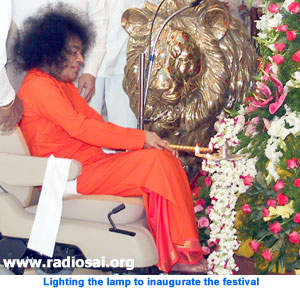 Some of the devotees sanctify the time by meditating; others roll the prayer beads in their fingers mumbling softly their favourite mantra. The only sounds that permeate Sai Kulwant are the twitter of swallows playing in the rafters of the hall and the cooing of the pigeons that have made SKH their home.
Some of the devotees sanctify the time by meditating; others roll the prayer beads in their fingers mumbling softly their favourite mantra. The only sounds that permeate Sai Kulwant are the twitter of swallows playing in the rafters of the hall and the cooing of the pigeons that have made SKH their home. 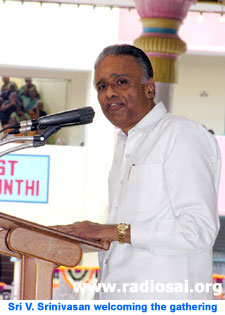 After they had come, Swami left for a couple of days to Brindavan but leaving behind the cryptic instruction for the children to continue practising their routines and that He would be back. So while speculation abounded in the minds of the adults - would He be back in time? - the little ones had no such doubts.
After they had come, Swami left for a couple of days to Brindavan but leaving behind the cryptic instruction for the children to continue practising their routines and that He would be back. So while speculation abounded in the minds of the adults - would He be back in time? - the little ones had no such doubts. 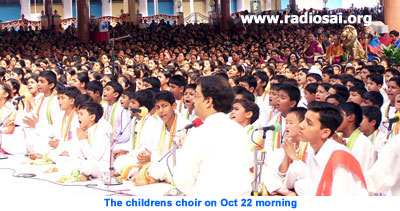
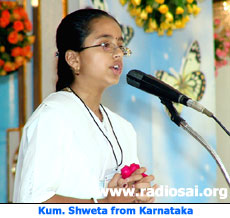
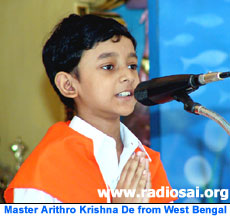
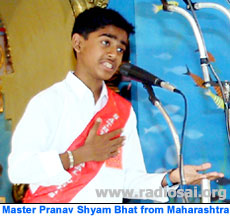

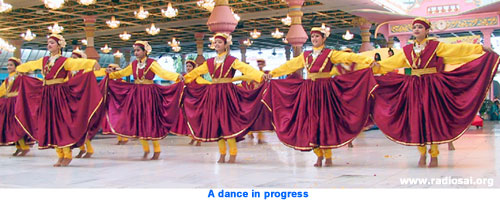
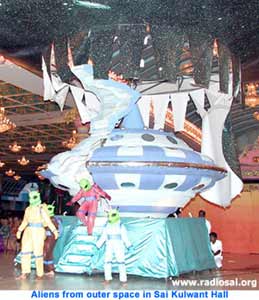 The afternoon programme of the 22nd was an enchanting musical by the young kids entitled, "The Glory of Sathya Sai."
The afternoon programme of the 22nd was an enchanting musical by the young kids entitled, "The Glory of Sathya Sai."  The Hindu religion also known as "Sanathana Dharma" was presented by the children from Tamil Nadu. The Vedas are the life breath of Sanathana Dharma and the Vedas gives importance to Yagas and Yagnas, which promote peace and prosperity in the world. Yaga means the giving up the material (or sacrifice) for the sake of the divine.
The Hindu religion also known as "Sanathana Dharma" was presented by the children from Tamil Nadu. The Vedas are the life breath of Sanathana Dharma and the Vedas gives importance to Yagas and Yagnas, which promote peace and prosperity in the world. Yaga means the giving up the material (or sacrifice) for the sake of the divine.
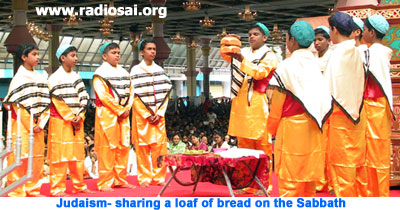
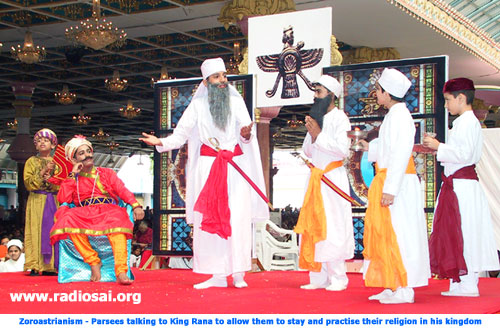
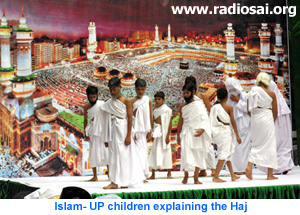
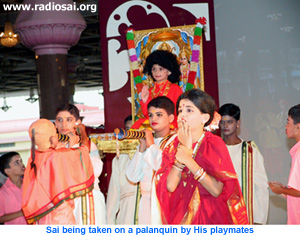 The afternoon programme on the 23rd was entirely orchestrated by the children of the Sri Sathya Sai Primary School . So many children participated that it looked like the whole Primary School had a role to play in front of Swami.
The afternoon programme on the 23rd was entirely orchestrated by the children of the Sri Sathya Sai Primary School . So many children participated that it looked like the whole Primary School had a role to play in front of Swami. 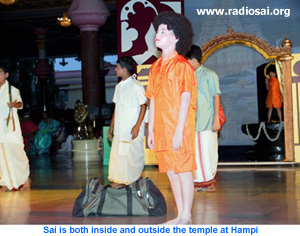 The play was done against a projection of videos of relevant portions of Sai's life in the back-ground in consonance with the depiction of His life in the foreground by the children. The play was further enlivened using the novel concept of showing illuminary devotees like Kasturi sharing in Sai's glory.
The play was done against a projection of videos of relevant portions of Sai's life in the back-ground in consonance with the depiction of His life in the foreground by the children. The play was further enlivened using the novel concept of showing illuminary devotees like Kasturi sharing in Sai's glory. 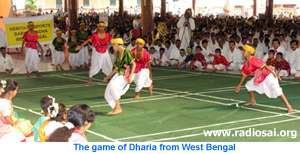 The morning of October 24th, the last day of the 3 day festival, was enlivened by what was called Heritage Sports, a depiction of games played in the rural parts of Andhra Pradesh, Maharashtra , Orissa, West Bengal and Jharkhand. These games were played in the yester years, before the ubiquitous influence of TV and sports like cricket and football. These easy to play games with simple rules and little props or kits brought about a sense of unity and brotherliness with a respect for the rural way of life.
The morning of October 24th, the last day of the 3 day festival, was enlivened by what was called Heritage Sports, a depiction of games played in the rural parts of Andhra Pradesh, Maharashtra , Orissa, West Bengal and Jharkhand. These games were played in the yester years, before the ubiquitous influence of TV and sports like cricket and football. These easy to play games with simple rules and little props or kits brought about a sense of unity and brotherliness with a respect for the rural way of life. 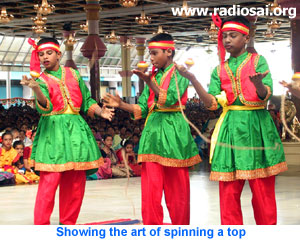 Rural games with authentic village names were displayed - like Daria Bandha (where one defence teams standing in parallel lines prevents the enemy from crossing over); Karra Saamu (or stick fight) a martial art form from Andhra Pradesh using body length bamboo sticks developed first as a self-defence necessity but later developed into an art form; and Atya Patya, a team game from Maharashtra wherein a rectangular playfield is divided into squares called trenches.
Rural games with authentic village names were displayed - like Daria Bandha (where one defence teams standing in parallel lines prevents the enemy from crossing over); Karra Saamu (or stick fight) a martial art form from Andhra Pradesh using body length bamboo sticks developed first as a self-defence necessity but later developed into an art form; and Atya Patya, a team game from Maharashtra wherein a rectangular playfield is divided into squares called trenches. 
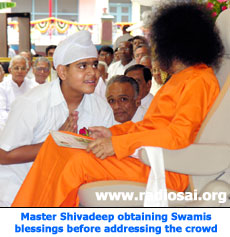
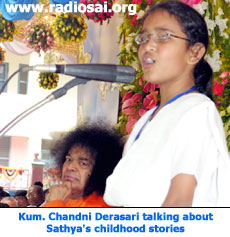

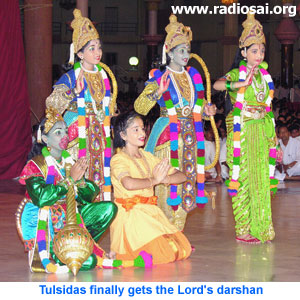 The melodious songs and well choreographed dances portraying these holy lives were very inspiring for all. Saint Tulsidas, an ardent Rama Bhaktha was born in a poor family in Rajpur in Uttar Pradesh. He married early and initially dotes on his wife, forgetting the Lord's name.
The melodious songs and well choreographed dances portraying these holy lives were very inspiring for all. Saint Tulsidas, an ardent Rama Bhaktha was born in a poor family in Rajpur in Uttar Pradesh. He married early and initially dotes on his wife, forgetting the Lord's name. 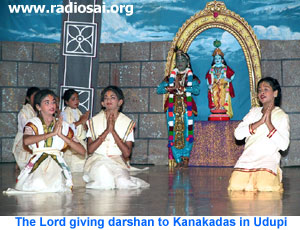 Kanakadas was one of the foremost saints of Karnataka propagating the path of bhakti. Once his guru gave his disciples a banana and asked them to eat it without being noticed by anyone.
Kanakadas was one of the foremost saints of Karnataka propagating the path of bhakti. Once his guru gave his disciples a banana and asked them to eat it without being noticed by anyone.  Bhagavan inaugurated the conference in the morning of the 25th by lighting the lamp. Delivering the keynote address on this occasion, Mrs. Sarla Shah, the National BalaVikas Co-ordinator, highlighted the evolution of the Bala Vikas movement from the early time to the present Sai Educare and its application to everyday life.
Bhagavan inaugurated the conference in the morning of the 25th by lighting the lamp. Delivering the keynote address on this occasion, Mrs. Sarla Shah, the National BalaVikas Co-ordinator, highlighted the evolution of the Bala Vikas movement from the early time to the present Sai Educare and its application to everyday life. 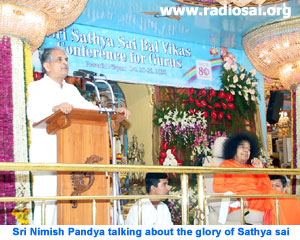

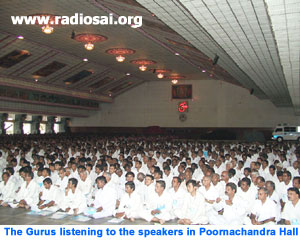 The session commenced with a talk by Smt. Kamala Pandya on "Sri Sathya Sai Bala Vikas - a Milestone in the Divine Mission". Dr. Anand Mohan next elaborated on "Sri Sathya Sai Bala Vikas - a Way of Life".
The session commenced with a talk by Smt. Kamala Pandya on "Sri Sathya Sai Bala Vikas - a Milestone in the Divine Mission". Dr. Anand Mohan next elaborated on "Sri Sathya Sai Bala Vikas - a Way of Life".  Ms Neeta Khanna ("Importance of Thought management"), Smt. Parul Sachadeva ("Importance of Good Habit Formation for Character Building"), Ms Shasibala from A.P. ("Importance of the Integration of the 5 Techniques in Imparting Course Content") and Dr Devi Rajagopal (who gave an insight on the benchmarks of an ideal Bala Vikas student) talked on the technical aspects of the Bala Vikas movement.
Ms Neeta Khanna ("Importance of Thought management"), Smt. Parul Sachadeva ("Importance of Good Habit Formation for Character Building"), Ms Shasibala from A.P. ("Importance of the Integration of the 5 Techniques in Imparting Course Content") and Dr Devi Rajagopal (who gave an insight on the benchmarks of an ideal Bala Vikas student) talked on the technical aspects of the Bala Vikas movement. The second part of the afternoon session on Oct 26th was held in the Divine presence in Sai Kulwant Hall. Smt. Usha Nair enriched the audience by sharing her experiences in rural Bala Vikas.
The second part of the afternoon session on Oct 26th was held in the Divine presence in Sai Kulwant Hall. Smt. Usha Nair enriched the audience by sharing her experiences in rural Bala Vikas. 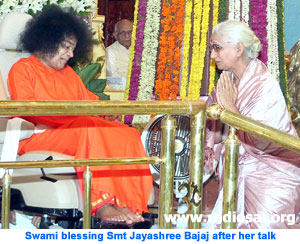
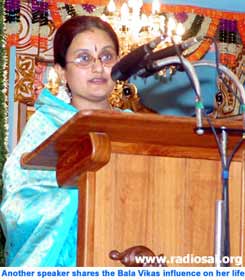
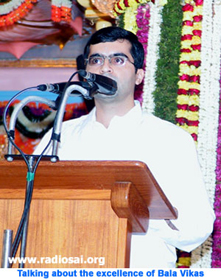


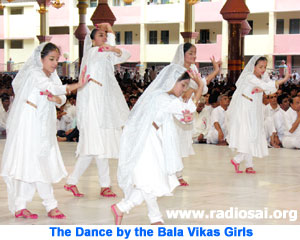

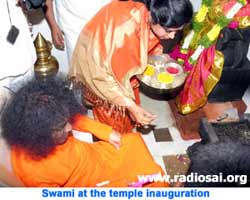
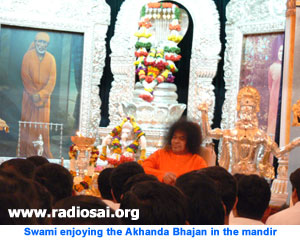
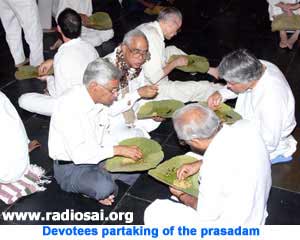
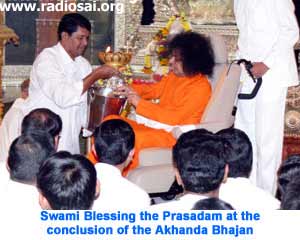
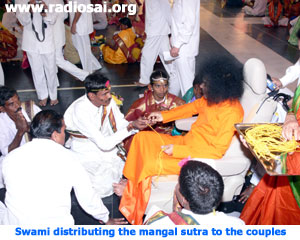 On the morning of the 17th the entire Sai Kulwant Hall was decorated as a marriage pandal or hall. Done up exquisitely with traditional mango buntings and flowers, it was the occasion of the marriage of 80 blessed and lucky couples in the divine presence.
On the morning of the 17th the entire Sai Kulwant Hall was decorated as a marriage pandal or hall. Done up exquisitely with traditional mango buntings and flowers, it was the occasion of the marriage of 80 blessed and lucky couples in the divine presence.  Swami went around the hall and personally distributed the mangal sutra (or the wedding band) that the groom ties around the bride.
Swami went around the hall and personally distributed the mangal sutra (or the wedding band) that the groom ties around the bride.  But the copious giving still did not end. After the end of the Vedic wedding ceremony, when the bride and the groom had now become a wedded couple, the elders normally bless them by sprinkling akshada (rice mixed with turmeric powder) on their heads. These blessed and lucky couples had the rarest of rare fortunes to be blessed by the Lord Himself, for Sai decided that He was going to go around for the third time amongst these chosen couples and bless them Himself. There was scarce a dry eye as the Lord went around again, ignoring all physical discomforts and lovingly blessed each and every one of the couples who had got married on that morning by sprinkling akshada on their heads!
But the copious giving still did not end. After the end of the Vedic wedding ceremony, when the bride and the groom had now become a wedded couple, the elders normally bless them by sprinkling akshada (rice mixed with turmeric powder) on their heads. These blessed and lucky couples had the rarest of rare fortunes to be blessed by the Lord Himself, for Sai decided that He was going to go around for the third time amongst these chosen couples and bless them Himself. There was scarce a dry eye as the Lord went around again, ignoring all physical discomforts and lovingly blessed each and every one of the couples who had got married on that morning by sprinkling akshada on their heads!  The Rathothsavam festival is always held on the morning of the 18th of November, when the deities of Rama, Lakshmana and Sita along with their bhaktha Hanuman is taken out along the streets of the village right up to the Old Kalyana Mantapam.
The Rathothsavam festival is always held on the morning of the 18th of November, when the deities of Rama, Lakshmana and Sita along with their bhaktha Hanuman is taken out along the streets of the village right up to the Old Kalyana Mantapam. This is followed by the students singing bhajans and then come the 2 chariots. The Rama, Sita and Lakshmana deities go first, with Lord Krishna in a big chariot bringing up the rear. The streets of the village have been freshly washed by the citizens and intricate floral patterns (called rangolis) have been drawn on the clean roads through which the chariots are going to pass.
This is followed by the students singing bhajans and then come the 2 chariots. The Rama, Sita and Lakshmana deities go first, with Lord Krishna in a big chariot bringing up the rear. The streets of the village have been freshly washed by the citizens and intricate floral patterns (called rangolis) have been drawn on the clean roads through which the chariots are going to pass.  During the Tang Dynasty in China , the Chinese scholar and monk - Xuan Zang, traveled to India to bring back the sacred teachings of the Buddha to China .
During the Tang Dynasty in China , the Chinese scholar and monk - Xuan Zang, traveled to India to bring back the sacred teachings of the Buddha to China . 
 captured the entire audience and held them hostage to each tug of the bow and each strum of the strings from these unusual instruments.
captured the entire audience and held them hostage to each tug of the bow and each strum of the strings from these unusual instruments.  Yet another red letter day for Ladies dawned this year on Nov 19th. On this day all the Mandir activities starting from the morning Suprabhatham to the Nagarsankeertan are carried out exclusively by ladies.
Yet another red letter day for Ladies dawned this year on Nov 19th. On this day all the Mandir activities starting from the morning Suprabhatham to the Nagarsankeertan are carried out exclusively by ladies. 

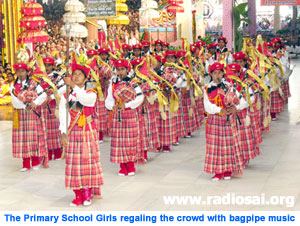
 The first speaker was Smt. Mallika Srinivasan, an MBA from the Wharton School of Business, University of Pennsylvania, USA and Director of Tractors and Farm Equipment Limited (TAFE). She said, "Bhagavan’s Omnipresence makes each one of our experiences unique and personal. As we each personally experience His grace we see Him in a variety of hues as a parent as a teacher, as a personal guide as a protector from danger as a corporate guru, as a friend and as God.
The first speaker was Smt. Mallika Srinivasan, an MBA from the Wharton School of Business, University of Pennsylvania, USA and Director of Tractors and Farm Equipment Limited (TAFE). She said, "Bhagavan’s Omnipresence makes each one of our experiences unique and personal. As we each personally experience His grace we see Him in a variety of hues as a parent as a teacher, as a personal guide as a protector from danger as a corporate guru, as a friend and as God.  Smt. Geeta Ram, a school teacher from Washington D.C., speaking next, related enthralling incidents from her life showing Swami's omnipresence and omnipotence. The first incident related to her family and her infant son who was raised on Glaxo baby food.
Smt. Geeta Ram, a school teacher from Washington D.C., speaking next, related enthralling incidents from her life showing Swami's omnipresence and omnipotence. The first incident related to her family and her infant son who was raised on Glaxo baby food.  The third speaker for the morning was Smt. Chetana Raju, who spoke about Bhagavan's mission and exhorted everyone to derive the maximum benefit of having the Lord in our midst. She said, "What is 80 years for the One who is ageless? What is 80 years of earthly existence for the One who is beyond time? What is 80 years for the One who is proclaimed by the Vedas as Sathya Brahman? And what is 80 years for Sri Sathya Sai who is existence eternal?
The third speaker for the morning was Smt. Chetana Raju, who spoke about Bhagavan's mission and exhorted everyone to derive the maximum benefit of having the Lord in our midst. She said, "What is 80 years for the One who is ageless? What is 80 years of earthly existence for the One who is beyond time? What is 80 years for the One who is proclaimed by the Vedas as Sathya Brahman? And what is 80 years for Sri Sathya Sai who is existence eternal? 

 Kavitha Subramaniam began her recital with the famous song, “Janam Diya Tune Sai Ko …”, about Mother Easwaramma because of whom we have the Lord in our midst. A few of her other songs were – “Mein Aayi Thi Darshan Paane …” (I came for your darshan …), "Meine Prem Ki Jyoti Jalayi …" (I lit the lamp of love …) and also the ever famous number "Dhanyabaag Seva Ka Avsar Paya …" (I won an opportunity to do service, I am extremely grateful …). She also sang some bhajans -“Nanda Nandana Hari Govinda Gopala …”, “Raghupati Raghava Raja Ram …” and “Antaranga Sai Anatha Natha Sai …” Her soulful and mellifluous voice has a surreal quality that makes one dissolve totally in the music and forget mundane body consciousness.
Kavitha Subramaniam began her recital with the famous song, “Janam Diya Tune Sai Ko …”, about Mother Easwaramma because of whom we have the Lord in our midst. A few of her other songs were – “Mein Aayi Thi Darshan Paane …” (I came for your darshan …), "Meine Prem Ki Jyoti Jalayi …" (I lit the lamp of love …) and also the ever famous number "Dhanyabaag Seva Ka Avsar Paya …" (I won an opportunity to do service, I am extremely grateful …). She also sang some bhajans -“Nanda Nandana Hari Govinda Gopala …”, “Raghupati Raghava Raja Ram …” and “Antaranga Sai Anatha Natha Sai …” Her soulful and mellifluous voice has a surreal quality that makes one dissolve totally in the music and forget mundane body consciousness.
 The bus contains an X-ray unit, ultra sound scanner, automatic film processor, Schiller ECG machine, a semi-automatic chemistry analyzer, a binocular microscope, ophthalmoscope, otoscope, retinoscope, foldable simple table for x-ray, foldable screen with stand and an LCD projector.
The bus contains an X-ray unit, ultra sound scanner, automatic film processor, Schiller ECG machine, a semi-automatic chemistry analyzer, a binocular microscope, ophthalmoscope, otoscope, retinoscope, foldable simple table for x-ray, foldable screen with stand and an LCD projector.  175 members from 45 countries had put in hours of practice over the past few days to blend their voices in perfect harmony to produce mellifluous music that touched everyone's hearts.
175 members from 45 countries had put in hours of practice over the past few days to blend their voices in perfect harmony to produce mellifluous music that touched everyone's hearts.  In The Morning
In The Morning
 Taking as a theme Swami’s instruction “Love is one, live in love!” given on His Ladies' Day Discourse 2005, the 53 musicians from over 20 countries in Asia, Australia, Europe, North, Central and South America worked together during five days of rehearsals in a joyful spirit of unity and love so that they could perform their best before their Sweet Lord.
Taking as a theme Swami’s instruction “Love is one, live in love!” given on His Ladies' Day Discourse 2005, the 53 musicians from over 20 countries in Asia, Australia, Europe, North, Central and South America worked together during five days of rehearsals in a joyful spirit of unity and love so that they could perform their best before their Sweet Lord. 
 This year for the 8th congress more than 10,000 delegates from India and about 3000 delegates from over 120 countries participated and deliberated about the future course and direction of the Organization.
This year for the 8th congress more than 10,000 delegates from India and about 3000 delegates from over 120 countries participated and deliberated about the future course and direction of the Organization. 

 Dr. Michael Goldstein, Chair of the Prashanti Council and Chairman of the International Sathya Sai Organisation, ended the inaugural proceedings eloquently by talking about the theme of the conference: Unity, Purity and Divinity. He mentioned that Unity, Purity, and Divinity were not three distinct things but three stages in our spiritual path. At the end of the path, we would experience what we really are - a personification of Love.
Dr. Michael Goldstein, Chair of the Prashanti Council and Chairman of the International Sathya Sai Organisation, ended the inaugural proceedings eloquently by talking about the theme of the conference: Unity, Purity and Divinity. He mentioned that Unity, Purity, and Divinity were not three distinct things but three stages in our spiritual path. At the end of the path, we would experience what we really are - a personification of Love. 













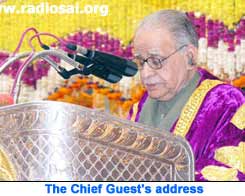





 However, troubles soon appear. Mr. Praneet starts behaving indifferently and soon resigns to the anger of his associates. Without a good architect, the project is behind schedule and costs shoot way over the budget. Cement prices also skyrocket and soon the company is in dire financial straits. At this juncture, Mr. Saket Sharma, a world famous architect, offers his services free of cost to this noble cause and his genius brings the costs down to manageable levels.
However, troubles soon appear. Mr. Praneet starts behaving indifferently and soon resigns to the anger of his associates. Without a good architect, the project is behind schedule and costs shoot way over the budget. Cement prices also skyrocket and soon the company is in dire financial straits. At this juncture, Mr. Saket Sharma, a world famous architect, offers his services free of cost to this noble cause and his genius brings the costs down to manageable levels. 





 Perhaps at His signal, the festivities soon began - first with a Amala Shankar & troupe welcome dance on the specially constructed stage. All eyes were still riveted on the Lord and it was difficult to tear the eyes away even to just peek at the dancers on the stage. Next on the agenda were contingents from 4 countries that marched past Shanti Vedika to hail the Lord on His Birthday while the specially prepared birthday song played in the back-ground.
Perhaps at His signal, the festivities soon began - first with a Amala Shankar & troupe welcome dance on the specially constructed stage. All eyes were still riveted on the Lord and it was difficult to tear the eyes away even to just peek at the dancers on the stage. Next on the agenda were contingents from 4 countries that marched past Shanti Vedika to hail the Lord on His Birthday while the specially prepared birthday song played in the back-ground.  Then, Sri Sunil Gavaskar, the Master of Ceremonies, invited Maj. Rajyavardhan Singh Rathore to hoist the Global Peace Insignia for the well being of humanity. After receiving Bhagavan's blessings Maj. Rathore took the insignia out of Shanti Vedika and ran up to the specially erected stage like an Olympic torch bearer and then showed the logo to the enormous gathering before it was finally hoisted up the hill to the highest point of the stadium near the Hanuman Statue. …And then the 80th birthday message was unfurled down the hill slope - “May there be Peace, Unity and Love in the World”.
Then, Sri Sunil Gavaskar, the Master of Ceremonies, invited Maj. Rajyavardhan Singh Rathore to hoist the Global Peace Insignia for the well being of humanity. After receiving Bhagavan's blessings Maj. Rathore took the insignia out of Shanti Vedika and ran up to the specially erected stage like an Olympic torch bearer and then showed the logo to the enormous gathering before it was finally hoisted up the hill to the highest point of the stadium near the Hanuman Statue. …And then the 80th birthday message was unfurled down the hill slope - “May there be Peace, Unity and Love in the World”.  The first speaker for the session was Sri Indulal Shah, formerly World Chairman of Sri Sathya Sai Organisations, and currently Advisor to the Prashanti Council, the overseeing body for the Overseas Sathya Sai Organisations. Mr. Shah while offering his prayerful salutations at His Lotus Feet said,
The first speaker for the session was Sri Indulal Shah, formerly World Chairman of Sri Sathya Sai Organisations, and currently Advisor to the Prashanti Council, the overseeing body for the Overseas Sathya Sai Organisations. Mr. Shah while offering his prayerful salutations at His Lotus Feet said,  He further added that Bhagavan’s Message of Love is beyond countries, culture, religion and race and it is time for all of us to blend into a Brotherhood of Mankind.
He further added that Bhagavan’s Message of Love is beyond countries, culture, religion and race and it is time for all of us to blend into a Brotherhood of Mankind. 

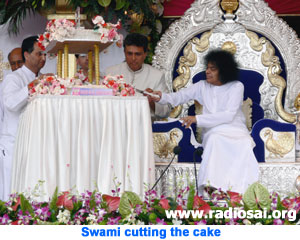
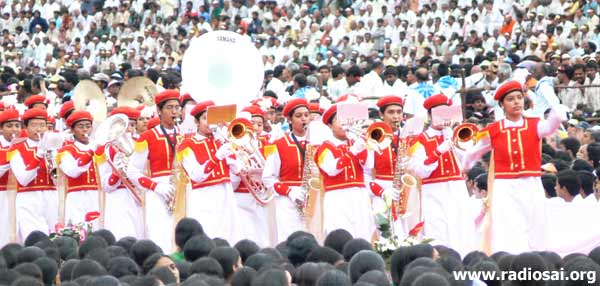
 Swami came to the Stadium in the afternoon in an open car but now in a bright yellow robe, looking like Sai Krishna. Swami was led to the stadium by a long procession of performing artistes from the different States of India.
Swami came to the Stadium in the afternoon in an open car but now in a bright yellow robe, looking like Sai Krishna. Swami was led to the stadium by a long procession of performing artistes from the different States of India.  While He sat there giving a feast for everyone's eyes, a welcome was sung in the background with the lyrics “Sai’s Birthday is a festival for Sathya, Dharma, Shanti and Prema. Happy Birthday to You Bhagavan.”
While He sat there giving a feast for everyone's eyes, a welcome was sung in the background with the lyrics “Sai’s Birthday is a festival for Sathya, Dharma, Shanti and Prema. Happy Birthday to You Bhagavan.”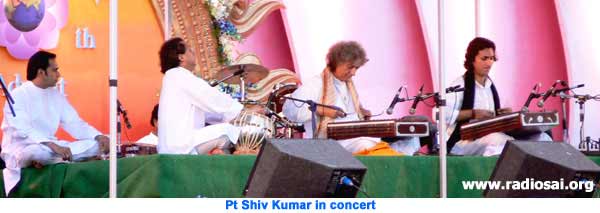


 The music programme was interspersed with green streaks of light originating from the hill-side making and breaking green patterns all over the stadium. The laser show had started with appropriate instrumental music in the back-ground, thrilling the rural populace who were seeing such a show for the first time in their lives.
The music programme was interspersed with green streaks of light originating from the hill-side making and breaking green patterns all over the stadium. The laser show had started with appropriate instrumental music in the back-ground, thrilling the rural populace who were seeing such a show for the first time in their lives. 




